
Wetenschap
Chinese capsule keert terug naar aarde met maanstenen
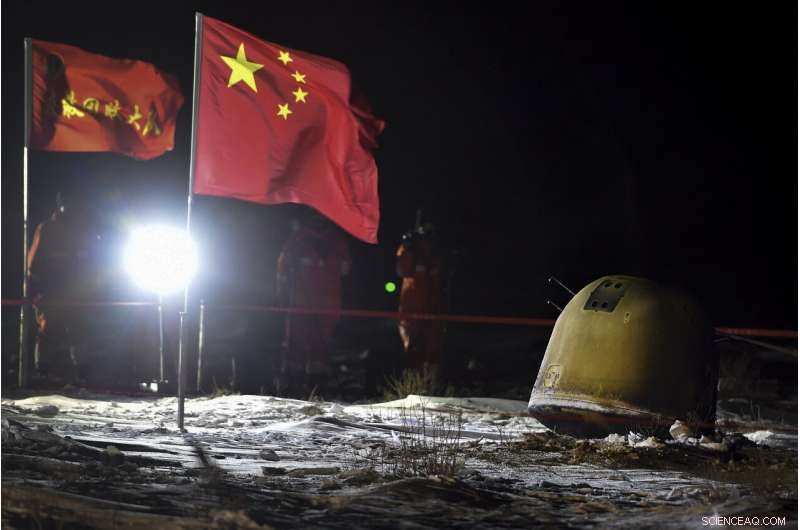
Op deze foto vrijgegeven door Xinhua News Agency, herstelploegleden filmen de capsule van de Chang'e 5-sonde na de succesvolle landing in het Siziwang-district, Noord-China's autonome regio Binnen-Mongolië op donderdag, 17 december 2020. Een Chinese maancapsule keerde donderdag terug naar de aarde met de eerste verse monsters van gesteente en puin van de maan in meer dan 40 jaar. (Ren Junchuan/Xinhua via AP)
Een Chinese maancapsule keerde donderdag terug naar de aarde met de eerste verse gesteentemonsters van de maan in meer dan 40 jaar, biedt de mogelijkheid tot nieuwe inzichten in de geschiedenis van het zonnestelsel en markeert een nieuwe mijlpaal voor China's snel voortschrijdende ruimtevaartprogramma.
De capsule van de Chang'e 5-sonde landde net voor 2 uur (1800 GMT woensdag) in het Siziwang-district van de regio Binnen-Mongolië, meldde de China National Space Administration.
De capsule had zich eerder losgemaakt van zijn orbitermodule en stuiterde tegen de atmosfeer van de aarde om zijn snelheid te verminderen voordat hij erdoorheen ging en aan parachutes naar de grond dreef. Na herstel, de capsule en de lading monsters werden naar de campus van het ruimteprogramma in Peking gevlogen om te beginnen met het proces van demontage en analyse, aldus het ruimtebestuur.
De missie behaalde nieuwe primeurs voor het maanverkenningsprogramma bij het verzamelen van monsters, een voertuig lanceren vanaf het oppervlak van de maan en het koppelen aan de capsule om de monsters terug te brengen naar de aarde, aldus de administratie.
"Als de meest complexe en technisch baanbrekende ruimtemissie van ons land, Chang'e 5 heeft meerdere technische doorbraken bereikt ... en vertegenwoordigt een mijlpaal, " het zei.
Twee van de vier modules van de Chang'e 5 zijn op 1 december op de maan neergezet en hebben ongeveer 2 kilogram (4,4 pond) monsters verzameld door ze van het oppervlak te scheppen en 2 meter (ongeveer 6 voet) in de maankorst te boren. De monsters werden gedeponeerd in een verzegelde container die door een opstijgend voertuig werd teruggebracht naar de retourmodule.
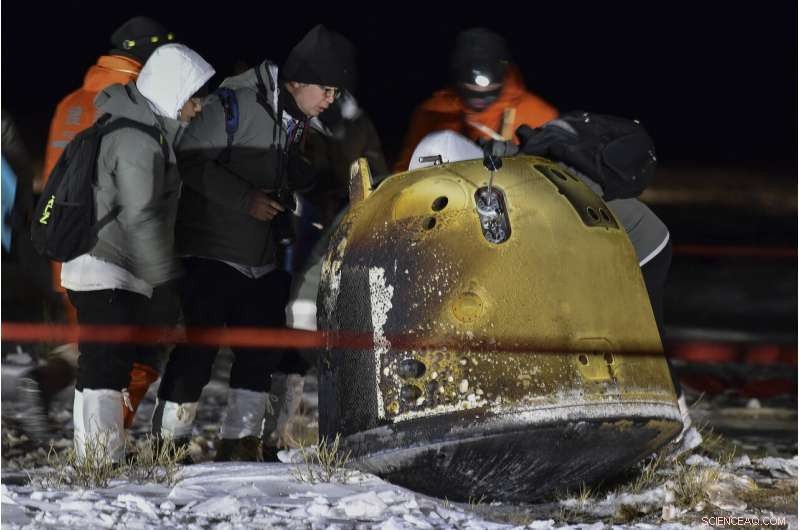
Op deze foto vrijgegeven door Xinhua News Agency, reddingsploegleden controleren de capsule van de Chang'e 5-sonde nadat deze succesvol was geland in het Siziwang-district, Noord-China's autonome regio Binnen-Mongolië op donderdag, 17 december 2020. Een Chinese maancapsule keerde donderdag terug naar de aarde met de eerste verse monsters van gesteente en puin van de maan in meer dan 40 jaar. (Ren Junchuan/Xinhua via AP)
Tot groot vermaak van de kijkers, beelden van de staatsomroep CCTV toonden een harig wit dier, mogelijk een vos of knaagdier, rennend voor de capsule terwijl deze op de grond lag, even stilstaan, alsof hij naar het onbekende object wil informeren.
Chinese leider Xi Jinping, in een verklaring voorgelezen in het Beijing Aerospace Control Center, noemde het een belangrijke prestatie die een grote stap voorwaarts betekende voor de Chinese ruimtevaartindustrie. Xi sprak de hoop uit dat missiedeelnemers zouden blijven bijdragen aan het uitbouwen van China tot een grote ruimtemacht en nationale verjonging, staatsbedrijf Xinhua News Agency gezegd.
Bergingsploegen hadden helikopters en terreinvoertuigen voorbereid om de signalen van het maanruimtevaartuig op te vangen en het te lokaliseren in de duisternis die het uitgestrekte met sneeuw bedekte gebied in het hoge noorden van China omhult, lang gebruikt als landingsplaats voor bemande Chinese ruimteschepen Shenzhou.
De terugkeer van het ruimtevaartuig was de eerste keer dat wetenschappers nieuwe monsters van maanrotsen hebben verkregen sinds de Luna 24-robotsonde van de voormalige Sovjet-Unie in 1976.
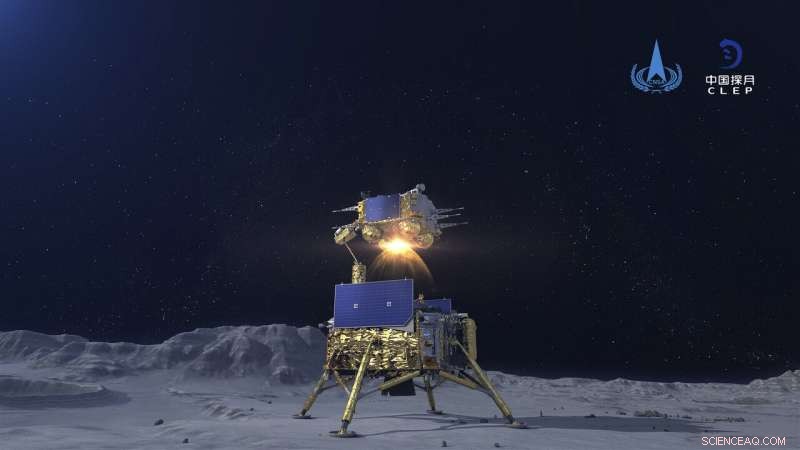
In deze China National Space Administration (CNSA) foto vrijgegeven door Xinhua News Agency, een gesimuleerd beeld van de opklimmer van het Chang'e-5-ruimtevaartuig dat op 3 december van het maanoppervlak afschiet in het Beijing Aerospace Control Center (BACC) in Beijing, 2020. De Chinese maansonde is donderdagavond van de maan opgestegen met een lading maanmonsters in de eerste fase van zijn terugkeer naar de aarde, staatsmedia gemeld. (China National Space Administration/Xinhua via AP)
Men denkt dat de nieuw verzamelde stenen miljarden jaren jonger zijn dan de stenen die eerder door de VS en de voormalige Sovjet-Unie werden verkregen. biedt nieuwe inzichten in de geschiedenis van de maan en andere lichamen in het zonnestelsel. They come from a part of the moon known as the Oceanus Procellarum, or Ocean of Storms, near a site called the Mons Rumker that was believed to have been volcanic in ancient times.
As with the 382 kilograms (842 pounds) of lunar samples brought back by U.S. astronauts from 1969 to 1972, they will be analyzed for age and composition and are expected to be shared with other countries.
The age of the samples will help fill in a gap in knowledge about the history of the moon between roughly 1 billion and three billion years ago, Brad Jolliff, director of the McDonnell Center for the Space Sciences at Washington University in the U.S. city of St. Louis, wrote in an email. They may also yield clues as to the availability of economically useful resources on the moon such as concentrated hydrogen and oxygen, Jolliff said.
"These samples will be a treasure trove!" Jolliff wrote. "My hat is off to our Chinese colleagues for pulling off a very difficult mission; the science that will flow from analysis of the returned samples will be a legacy that will last for many, many years, and hopefully will involve the international community of scientists."

Op deze foto vrijgegeven door Xinhua News Agency, recovery crews look at the capsule of the Chang'e 5 probe after its successful landing at the main landing site in Siziwang district, north China's Inner Mongolia Autonomous Region on Thursday, 17 december 2020. A Chinese lunar capsule returned to Earth on Thursday with the first fresh samples of rock and debris from the moon in more than 40 years. (Peng Yuan/Xinhua via AP)
Chang'e 5 blasted off from a launch base in China's southern island province of Hainan on Nov. 24 and appeared to have completed its highly technically sophisticated mission without a hitch.
It marked China's third successful lunar landing but the only one to lift off again from the moon. Its predecessor, Verander 4, became the first probe to land on the moon's little-explored far side and continues to send back data on conditions that could affect a future extended stay by humans on the moon.
The moon has been a particular focus of the Chinese space program, which says it plans to land humans there and possibly construct a permanent base. No timeline or other details have been announced.
China also has joined the effort to explore Mars. In juli, it launched the Tianwen 1 probe, which was carrying a lander and a robot rover to search for water.
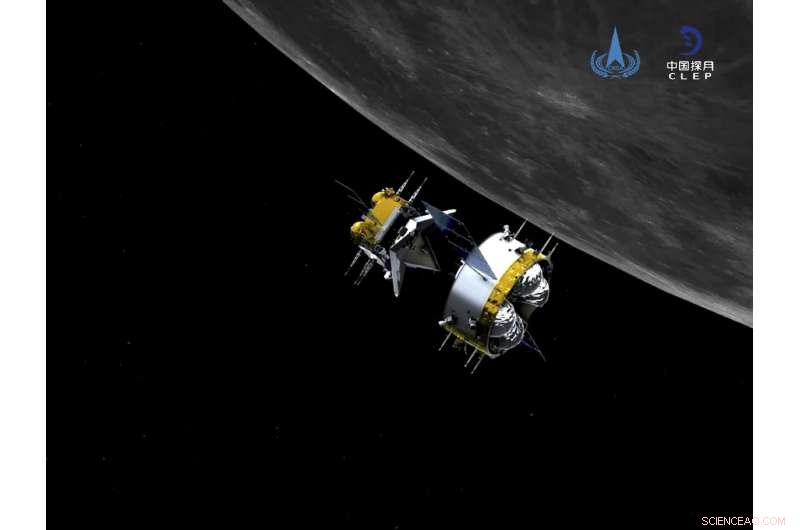
This graphic simulation image provided by China National Space Administration shows the orbiter and returner combination of China's Chang'e-5 probe after its separation from the ascender, at the Beijing Aerospace Control Center (BACC) in Beijing Sunday, Dec. 6, 2020. The Chinese probe that landed on the moon transferred rocks to an orbiter Sunday in preparation for returning samples of the lunar surface to Earth for the first time in almost 45 years, the country's space agency announced. (China National Space Administration/Xinhua via AP)
In 2003, China became the third country to send an astronaut into orbit on its own after the Soviet Union and the United States and its space program has proceeded more cautiously than the U.S.-Soviet space race of the 1960s, which was marked by fatalities and launch failures. By taking incremental steps, China appears on the path toward building a program that can sustain steady progress.
The latest flight includes collaboration with the European Space Agency, which is helping to monitor the mission. Amid concerns over the Chinese space program's secrecy and close military connections, the U.S. forbids cooperation between NASA and the CNSA unless Congress gives its approval. That has prevented China from taking part in the International Space Station, something it has sought to compensate for with the launching of an experimental space station and plans to complete a permanent orbiting outpost within the next two years.
© 2020 The Associated Press. Alle rechten voorbehouden. Dit materiaal mag niet worden gepubliceerd, uitzending, herschreven of gedistribueerd zonder toestemming.
 Realtime bewijs van morfologische veranderingen van stofdeeltjes als gevolg van interne vermenging met vervuiling
Realtime bewijs van morfologische veranderingen van stofdeeltjes als gevolg van interne vermenging met vervuiling China lanceert 's werelds eerste raket-ingezette weerinstrumenten van onbemand half-afzinkbaar voertuig
China lanceert 's werelds eerste raket-ingezette weerinstrumenten van onbemand half-afzinkbaar voertuig De typen zeebodembodems
De typen zeebodembodems  Giftige algen nemen toe in Lake Okeechobee in Florida
Giftige algen nemen toe in Lake Okeechobee in Florida Indonesiërs verstikt door bosbrandnevel bidden om regen
Indonesiërs verstikt door bosbrandnevel bidden om regen
Hoofdlijnen
- Geef twee redenen waarom het vrijwel onmogelijk is om veel menselijke eigenschappen te associëren met enkele genen
- Jonge vleermuizen leren vleermuisdialecten van hun nestgenoten
- Codominantie: definitie, toelichting en voorbeeld
- Hoe MRNA naar TRNA
- Neuron: definitie, structuur, functie en types
- Kenmerken levende cel
- Heb je testangst? Hier is hoe we het moeten aanpakken
- Hoe werkt het skelet met het ademhalingssysteem?
- Wetenschappers pleiten voor een wereldwijde kiembank
- NASA legt betoverende beelden vast van wolken die boven een verre wereld drijven

- Blikseminslag stelt lancering SpaceX uit tot zaterdag
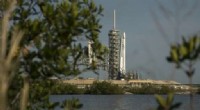
- NASA CubeSat-missie om vitale ruimteweergegevens te verzamelen

- Natuurkundigen ontwerpen een experiment om de oorsprong van de elementen vast te stellen

- Nieuw Russisch lab slaat ruimtestation even uit positie
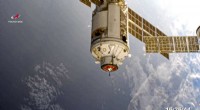
 Nieuwe oplossingen voor het aanpakken van systeemrisico's
Nieuwe oplossingen voor het aanpakken van systeemrisico's Aardbevingswetenschap had de nucleaire klim van Noord-Korea kunnen voorspellen
Aardbevingswetenschap had de nucleaire klim van Noord-Korea kunnen voorspellen Kunnen we kwantumcorrelaties op macroscopische schaal zien?
Kunnen we kwantumcorrelaties op macroscopische schaal zien? Hoe een balans van een driedubbelbundelsaldo te lezen
Hoe een balans van een driedubbelbundelsaldo te lezen Wetenschappers ontdekken nieuw magnetisch element
Wetenschappers ontdekken nieuw magnetisch element Nieuwe aanpak voor het oplossen van eiwitstructuren uit minuscule kristallen
Nieuwe aanpak voor het oplossen van eiwitstructuren uit minuscule kristallen Een nieuw bordspel ontworpen om de oude regels van mannelijkheid te leren
Een nieuw bordspel ontworpen om de oude regels van mannelijkheid te leren Wetenschappers ontdekken een betere manier om plastic uit zwavel te maken
Wetenschappers ontdekken een betere manier om plastic uit zwavel te maken
- Elektronica
- Biologie
- Zonsverduistering
- Wiskunde
- French | Italian | Spanish | Swedish | German | Dutch | Danish | Norway | Portuguese |

-
Wetenschap © https://nl.scienceaq.com

